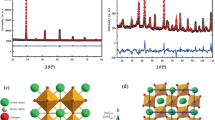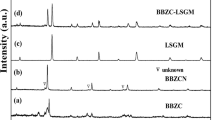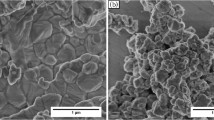Abstract
As the third generation of fuel cells, solid oxide fuel cell (SOFC) provides a clean and low-pollution technology. Electrolyte material, which often plays a vital role in SOFC, has always been the focus and difficulty of research. Y-doped barium cerate-based proton conductor electrolyte, BaCe1–xYxO3–δ (x = 0, 0.05, 0.1, 0.15), were prepared using the nitrate-citrate-glycine combustion method. A series of tests and characterizations were performed to examine the structural, morphological, and electrical properties. X-ray diffraction (XRD) analysis proved that the BCY powders with pure cubic perovskite structure were formed after calcined at 1100 °C. SEM results showed that the BCY ceramics sintered at 1350 °C were dense and well-developed grains. The electrochemical performance of BCY proton conductor electrolyte was determined using the electrochemical impedance spectroscopy in dry air and wet air atmosphere at 400–800 °C. Results showed that Y-doped BaCeO3-based material had superior conductivity in air and the conductivity of proton conductor was significantly improved under wet air environment. Furthermore, the electrical conductivity of BCY samples was related to the amount of Y3+ doping. The conductivity in a water vapor environment achieved a maximal value of 0.039 S cm−1 at 800 °C when x = 0.15. So BaCe1–xYxO3-based materials can be used as a proton conductor electrolyte for SOFC in the medium temperature range.











Similar content being viewed by others
Availability of data and materials
Dade will be made available on request.
References
L. He, H.Y. Gao, Y. Xuan, F. Zhang, J.F. Ren, M.N. Chen, Comp. Mater. Sci. 202, 111007 (2022)
H.O. Torun, S. Çakar, J. Therm. Anal. Calorim. 133, 1233–1239 (2018)
Raghvendra, R.K. Singh, A. Sinha, P. Singh, Ceram. Int. 40, 10711–10718 (2014)
I. Shajahan, J. Ahn, P. Nair, S. Medisetti, S. Patil, V. Niveditha, G.U.B. Babu, H.P. Dasari, J.-H. Lee, Mater. Chem. Phys. 216, 136–142 (2018)
S. Shawuti, Mater. Today. Commun. 30, 103000 (2022)
H. Shi, C. Su, R. Ran, J. Cao, Z. Shao, Prog. Nat. Sci-Mater. 30, 764–774 (2020)
T. Yamaguchi, H. Shimada, U. Honda, H. Kishimoto, T. Ishiyama, K. Hamamoto, H. Sumi, T. Suzuki, Y. Fujishiro, Solid State Ionics 288, 347–350 (2016)
J.Q. Li, Z.X. Zhu, Y.C. Huang, F. Wang, Mater. Today Energy. 26, 101001 (2022)
H. Iwahara, T. Esaka, H. Uchida, N. Maeda, Solid State Ionics 3–4, 359–363 (1981)
H. Iwahara, Solid State Ionics 52, 99–104 (1992)
J.Y. Lin, L. Shao, F.Z. Si, X.Z. Fu, J.L. Luo, Int. J. Hydrogen Energy 43, 19704–19710 (2018)
L. Bi, E.H. Da’as, S.P. Shafi, Electrochem. Commun. 80, 20–23 (2017)
T. Somekawa, Y. Matsuzaki, M. Sugahara, Y. Tachikawa, H. Matsumoto, S. Taniguchi, K. Sasaki, int. J. Hydrogen. Energy 42, 16722–16730 (2017)
Y.H. Ling, H. Chen, J. Niu, F. Wang, L. Zhao, X.M. Ou, T. Nakamura, K. Amezawa, J. Eur. Ceram. Soc. 36, 3423–3431 (2016)
H.X. Xie, Z.H. Wei, Y. Yang, H. Chen, X.M. Ou, B. Lin, Y. Ling, Mater. Sci. Eng. B 238–239, 76–82 (2018)
T. Shimada, C. Wen, N. Taniguchi, J. Otomo, H. Takahashi, J. Power. Sources 131, 289–292 (2004)
F. Zhao, S. Wang, L. Dixon, F. Chen, Jops. 196, 7500–7504 (2011)
T. Kuroha, Y. Niina, M. Shudo, G. Sakai, N. Matsunaga, T. Goto, K. Yamauchi, Y. Mikami, Y. Okuyama, Jops. 506, 230134 (2021)
D.S. Saini, A. Ghosh, S. Tripathy, S.K. Sharma, A. Kumar, D. Bhattacharya, Acs Appl Energ Mater. 1(7), 3469–3478 (2018)
D.S. Saini, A. Ghosh, S. Tripathy, A. Kumar, S.K. Sharma, N. Kumar, S. Majumdar, D. Bhattacharya, Sci. Rep. 10, 3461 (2018)
D. Han, T. Uda, J. Mater. Chem. A. 6, 18571–18582 (2018)
Y. Huang, R. Merkle, J. Maier, Solid State Ionics 347, 115174 (2020)
M.K. Hossain, T. Yamamoto, K. Hashizume, Ceram. Int. 47, 27177–27187 (2021)
D. Han, S. Uemura, C. Hiraiwa, M. Majima, T. Uda, Chemsuschem 11, 4102–4113 (2018)
H. Iwahara, H. Uchida, K. Ono, K. Ogaki, J. Electrochem. Soc. 135, 529–533 (1988)
X. Jiang, F. Wu, H. Wang, Materials. 12, 739 (2019)
Y. Gu, G. Luo, Z. Chen, Y. Huo, F. Wu, Ceram. Int. 48, 10650–10658 (2022)
V.C.D. Graça, F.J.A. Loureiro, L.I.V. Holz, S.M. Mikhalev, D.P. Fagg, Int. J. Energy Res. 46, 22113–22123 (2022)
Z. Zhu, S. Wang, Ceram. Int. 45, 19289–19296 (2019)
A. Senthil Kumar, R. Balaji, S. Jayakumar, Mater. Chem. Phys. 202, 82–88 (2017)
M. Gautam, A. Ahuja, A. Sinha, J. Sharma, P.K. Patro, A. Venkatasubramanian, Bull. Mater. Sci. 43, 239 (2020)
E.K. Shin, E. Anggia, J.S. Park, Solid State Ionics 339, 115007 (2019)
X. Zhou, N. Hou, T. Gan, L. Fan, Y. Zhang, J. Li, G. Gao, Y. Zhao, Y. Li, J. Power. Sources 495, 229776 (2021)
D. Vignesh, E. Rout, Comput. Condens. Matter. 33, e00763 (2022)
T.Z. Xiong, J.T. Li, J.C. Roy, M. Koroma, Z.X. Zhu, H. Yang, L. Zhang, T. Ouyang, M.-S. Balogun, M. Al-Mamun, J. Energy Chem. 81, 71–81 (2023)
A. Subramaniyan, J.H. Tong, R.P. O’Hayre, N.M. Sammes, J. Am. Ceram. Soc. 94, 1800–1804 (2011)
S. Rajendran, N.K. Thangavel, S. Alkatie, Y. Ding, L.M.R. Arava, J. Alloys Compd. 870, 159431 (2021)
W. Yang, L. Wang, Y. Li, H. Zhou, Z. He, C. Han, L. Dai, J. Alloys Compd. 868, 159117 (2021)
E. Vøllestad, V. Øygarden, J.S. Graff, M.F. Sunding, J.D. Pietras, J.M. Polfus, M.L. Fontaine, Acta Mater. 227, 117695 (2022)
G.B. Zhang, D.M. Smyth, Solid State Ionics 82, 153–160 (1995)
X. Yang, L. Jia, B. Pan, B. Chi, J. Pu, J. Li, J. Phys. Chem. C 124, 8024–8033 (2020)
S. Rajendran, N.K. Thangavel, H. Ding, Y. Ding, D. Ding, L.M.R. Arava, ACS Appl. Mater. Interfaces 12, 38275–38284 (2020)
S. Mumtaz, M.A. Ahmad, R. Raza, M.S. Arshad, B. Ahmed, M.N. Ashiq, G. Abbas, Ceram. Int. 43, 14354–14360 (2017)
M. Shahid, Ionics 28, 3583–3601 (2022)
I.A. Zvonareva, A.M. Mineev, N.A. Tarasova, X.Z. Fu, D.A. Medvedev, J. Adv. Ceram. 11, 1131–1143 (2022)
X.M. Liu, Z.G. Liu, J.H. Ouyang, Y.J. Gu, J. Xiang, F.Y. Yan, Electrochim. Acta 59, 464–469 (2012)
X. Xu, L. Bi, X.S. Zhao, J. Membr. Sci. 558, 17–25 (2018)
S.A. Rasaki, C. Liu, C. Lao, Z. Chen, Prog. Solid State Chem. 63, 100325 (2021)
H. Matsumoto, Y. Kawasaki, N. Ito, M. Enoki, T. Ishihara, Electrochem. Solid State Lett. 10(4), B77 (2007)
A.S. Babu, R. Bauri, Int. J. Hydrogen Energy 39(26), 14487–14495 (2014)
Funding
This project is kindly supported by the Nature Science Foundation of Anhui Province of China (2108085ME152) and the Talent Research Fund Project of Hefei University (21-22RC34).
Author information
Authors and Affiliations
Contributions
All authors contributed to the study conception and design. Material preparation, data collection and analysis were performed by HL, XZ and YC. The first draft of the manuscript was written by JC. All authors read and approved the final manuscript.
Corresponding author
Ethics declarations
Conflict of interest
There are no conflicts to declare.
Ethical approval
All authors consent to participate and consent to publish.
Additional information
Publisher's Note
Springer Nature remains neutral with regard to jurisdictional claims in published maps and institutional affiliations.
Rights and permissions
Springer Nature or its licensor (e.g. a society or other partner) holds exclusive rights to this article under a publishing agreement with the author(s) or other rightsholder(s); author self-archiving of the accepted manuscript version of this article is solely governed by the terms of such publishing agreement and applicable law.
About this article
Cite this article
Liang, H., Zhu, X., Chen, Y. et al. Nanoarchitectonics of yttrium-doped barium cerate-based proton conductor electrolyte for solid oxide fuel cells. Appl. Phys. A 130, 168 (2024). https://doi.org/10.1007/s00339-024-07341-w
Received:
Accepted:
Published:
DOI: https://doi.org/10.1007/s00339-024-07341-w




